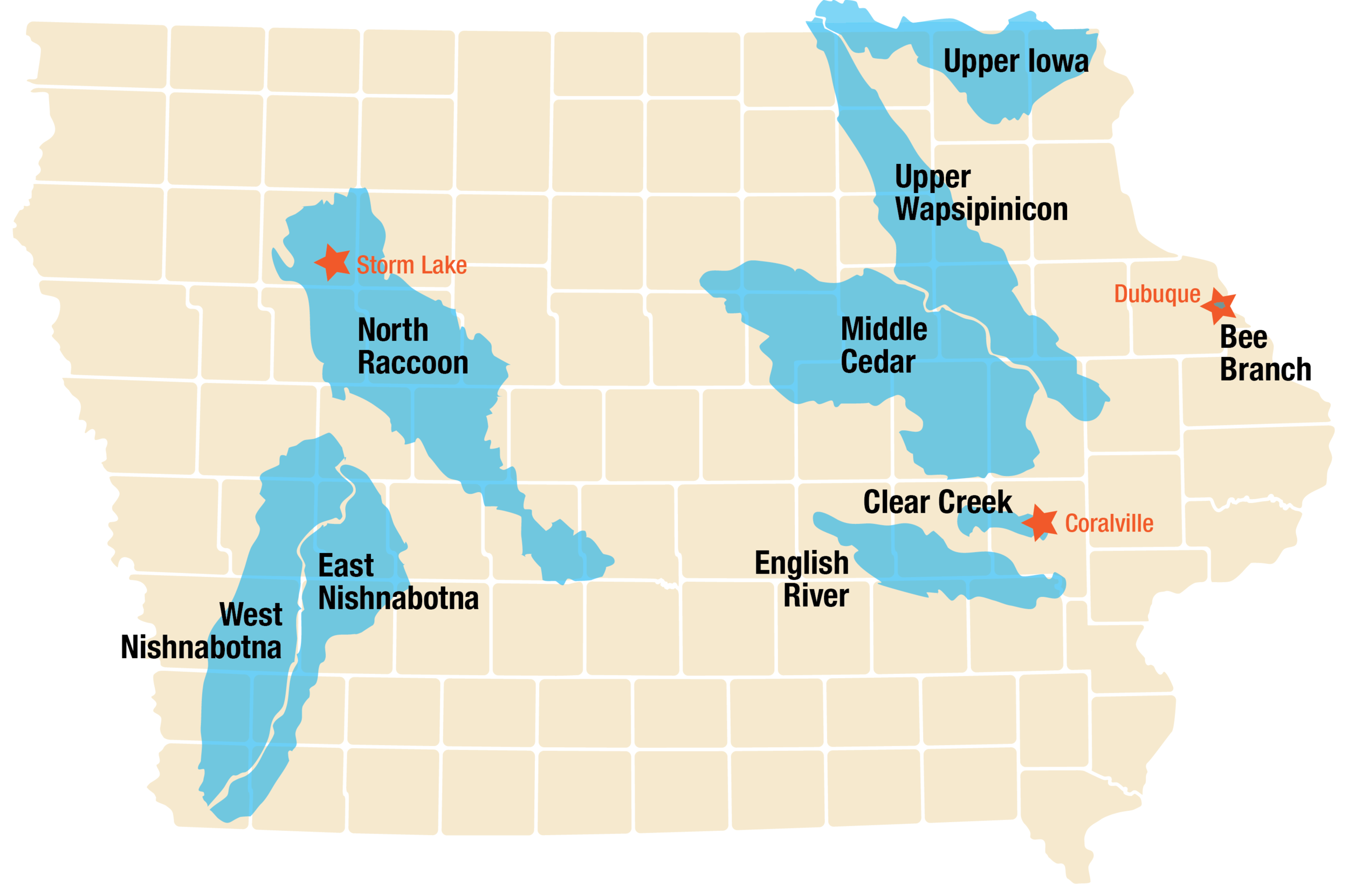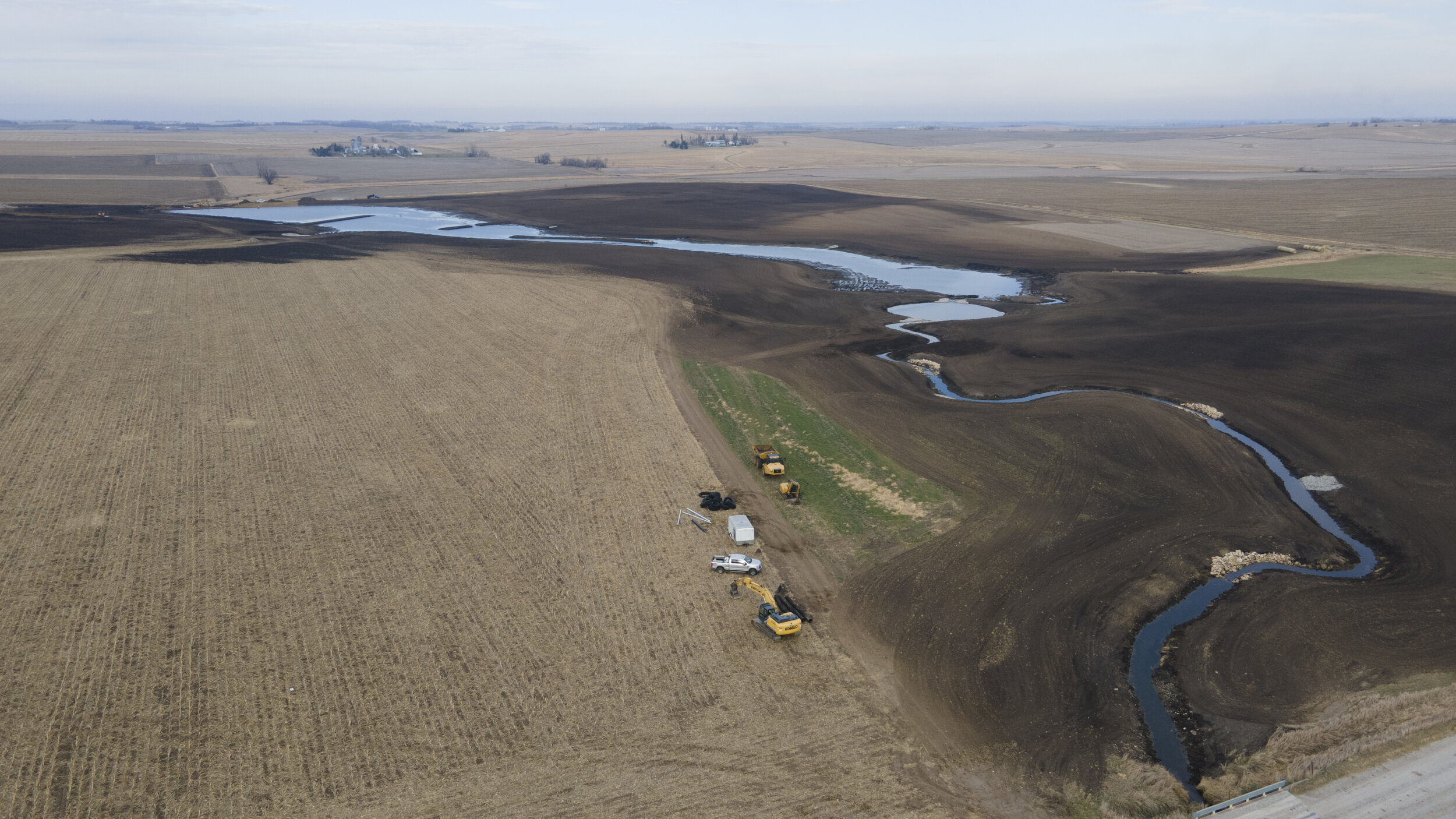Iowa: Building a Watershed Community Through Conservation Partnerships
By: Kate Giannini, Iowa Watershed Approach Communications Specialist, Iowa Flood Center
THE WATERSHED APPROACH
The Middle Cedar Watershed covers about 1.5 million acres in east central Iowa and spans 10 counties. Nearly 75% of the watershed consists of agricultural lands, with many small towns and three large metropolitan areas. Downstream sits Iowa’s second largest city of Cedar Rapids, which suffered devastating floods in 2008 and again in 2016. This watershed is identified as a priority area in the Iowa Nutrient Reduction Strategy, which is a framework to assess and reduce nutrients to Iowa waters and the Gulf of Mexico dead zone. The dead zone is an area of hypoxia the size of Rhode Island in the gulf where oxygen levels are so low due to excess nutrients, the waters can’t sustain marine life.
2008 Cedar Rapids flood
The Iowa Flood Center at the University of Iowa provided the vision for the IWA. This five-year program will sunset in December 2021. The IWA is active in nine watersheds across the state and has six specific goals:
1) Reduce flood risk;
2) Improve water quality;
3) Increase community flood resilience;
4) Engage stakeholders through collaboration, outreach, and education;
5) Improve quality of life and health for Iowans, especially for vulnerable populations; and
6) Develop a program that is scalable and replicable throughout the Midwest and United States.
In 2010, Iowa lawmakers passed legislation authorizing the creation of watershed management authorities (WMA). A WMA brings together cities, counties, soil and water conservation districts, and stakeholders to cooperatively engage in watershed planning and management.
The Middle Cedar WMA formed after Iowa received a $97 million grant from U.S. Housing and Urban Development for the Iowa Watershed Approach (IWA). The IWA is a collaboration including many statewide organizations and agencies. The IWA supports construction of flood mitigation projects with $30 million in funding. The Middle Cedar Watershed was allocated nearly $12 million and to date has already constructed nearly 70 wetlands, ponds, and other conservation practices, with another 30 coming by the end of 2021.
IWA Wetland (Photo credit: Iowa Flood Center)
The IWA program represents a vision for Iowa’s future that voluntarily engages stakeholders throughout the watershed to achieve common goals that lead to increased resiliency to natural disasters and to the overall improvement of public health in Iowa.
Jellison wetland (Photo credit: Iowa Flood Center)
Despite the main goal being flood reduction, these nature-based solutions are achieving multiple benefits, including enhanced wildlife habitat. While the size of the wetland projects vary in size from small to large, several of our sites exceed 20 acres and incorporate diverse native wetland and upland prairie seed mixes that are highly beneficial to wildlife and pollinators in a heavily agricultural landscape. Seeding requirements for all of our projects follow NRCS standards and specifications. The native seed mixes used are often based of predesigned seed mixes developed my Pheasants Forever. By the end of 2021, we will have seeded 175 acres of native prairie.
Adam Rodenberg, Middle Cedar watershed project coordinator. Rodenberg works directly with landowners, partners, and stakeholders to implement conservation projects.
“We’re creating resilient landscapes while finding mutual benefits for farmers, conservationists, and downstream stakeholders,” says Adam Rodenberg, Middle Cedar Watershed project coordinator. Partnering with a local watershed groups or a WMA is a great opportunity for local Pheasants Forever chapters to strengthen their habitat impact.
PARTNERSHIPS
These conservation investments could not be accomplished without partnerships. The Middle Cedar Watershed has been able to work with the IWA to stretch funds further and implement wetlands by collaborating with the Iowa Department of Agriculture and Land Stewardship (IDALS). “Watershed work is all about building relationships and instilling confidence that we’re all working together for the greater good. Our partners help us expand our reach in the community and often bring folks to the table who we haven’t connected with before,” says Rose Danaher, environmental specialist with IDALS.
Rose Danaher, environmental specialist, IDALS. Danaher provides technical support to landowners and communities in the Middle Cedar watershed.
In addition to IDALS, the following organizations have also invested funds in the Middle Cedar Watershed since 2015: The Nature Conservancy; NRCS-RCPP; Heartland Co-op; and the EPA Gulf of Mexico program, which together have leveraged an additional $3.5 million in the Middle Cedar Watershed. These organizations are committed to reaching the goals of nutrient reduction and flood mitigation through nature-based solutions with volunteer landowners.
North Carolina Delegation at Nick Meier’s farm in near La Porte City (Photo credit: Iowa Flood Center)
In 2019, a delegation from North Carolina traveled to Iowa to learn about the state’s efforts to become more flood-resilient. Faced with its own challenges from Hurricane Florence and many previous disasters, this group represented state and federal personnel, farmers, academic representatives, and conservation professionals, all looking to Iowa for expertise in flood risk tools, resources, and partner collaborations.
LEGACY
Danaher summarizes how conservation improvements serve multiple benefits and leave a lasting legacy. “When landowners implement additional conservation practices on the farm, it sets off a chain reaction beyond the initial water-quality and habitat improvements,” she says. “Quality hunting and fishing opportunities are an economic booster for rural towns; increased visibility of wildlife and habitat begets a stronger value for the resource. And perhaps most importantly, the mere presence of others caring for the land is contagious.”
Iowans can be proud to be seen as trailblazers in flood mitigation and nutrient reduction, but we have a long way to go to meet our goals. The intensification of agriculture is making it difficult to achieve measureable results. Partnerships, landowners, and dedicated water resource professionals such as Danaher and Rodenberg are setting the stage for conservation leadership while building a strong watershed community.







